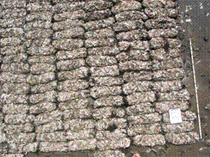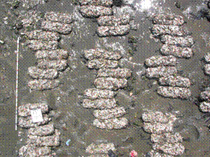The architecture of a reef includes materials used for construction that also may consist of one component as a base and another as veneer on top, the size (footprint), height (relative to the bottom), shape (circumference vs. area), slope (bank slope for intertidal), percent coverage of live oyster, available edge (see Figure), and surface rugosity or roughness. An important habitat component of reef architecture is the amount of interstitial space, which is the area in between shells that serves as refuge and nesting sites for associated fauna. Reefs with greater vertical relief can reduce the negative effects of spatial-temporal variability that determines spat set and adult survival. Vertical relief also can ameliorate the negative effects of near bottom hypoxic and sedimentation events and increase oyster growth and survival.


Examples of constructed reefs with reduced (top left) and increased (top right) edge or architecture (photos from L. Coen).







